A message from Electrical Builders, Ind.
America’s Top Performing Nuclear Plants Rely on Electrical Builders, Industries to Expand and Extend the Life of Their Critical Electrical Assets

A message from Electrical Builders, Ind.
America’s Top Performing Nuclear Plants Rely on Electrical Builders, Industries to Expand and Extend the Life of Their Critical Electrical Assets
The 800 billion kilowatt-hours of electricity produced by the 104 nuclear reactors in the United States each year -- all while emitting no greenhouse gases -- is by far America's biggest source of green energy. And this abundant energy source can become even greener by recycling used nuclear fuel.
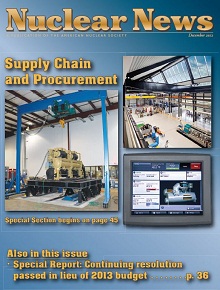 The December issue of Nuclear News magazine is available in hard copy and electronically for American Nuclear Society members (click 'ANS Members' or 'Subscribers' in left column).
The December issue of Nuclear News magazine is available in hard copy and electronically for American Nuclear Society members (click 'ANS Members' or 'Subscribers' in left column).
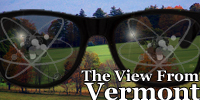 Some long-awaited events related to the continued operation of the Vermont Yankee nuclear power plant took place toward the end of 2012, such as the trial of some members of the Shut It Down Affinity Group (known to the media as the "nuclear grannies") who have been arrested many times for blocking Vermont Yankee's gates. Some unexpected events have occurred as well, such as a Public Service Board ruling and a brand new lawsuit by a long-term intervenor.
Some long-awaited events related to the continued operation of the Vermont Yankee nuclear power plant took place toward the end of 2012, such as the trial of some members of the Shut It Down Affinity Group (known to the media as the "nuclear grannies") who have been arrested many times for blocking Vermont Yankee's gates. Some unexpected events have occurred as well, such as a Public Service Board ruling and a brand new lawsuit by a long-term intervenor.
This morning, the 134th Carnival of Nuclear Bloggers is up, and is being hosted for the very first time on "Things Worse Than Nuclear Power." You can find the Carnival post here.
When you get right down to it... to many people, nuclear power can seem rather mysterious. Fortunately, this short video takes viewers inside US nuclear power plants and explains the nuts and bolts of how a nuclear plant operates-as told by the people who actually maintain and operate them.
Plus a few pointers to what's in store for 2013
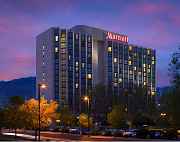 The 2013 ANS Topical Meeting on Nuclear and Emerging Technologies for Space (NETS 2013) will be held February 25-28, 2013, at the Albuquerque Marriott in Albuquerque, New Mexico.
The 2013 ANS Topical Meeting on Nuclear and Emerging Technologies for Space (NETS 2013) will be held February 25-28, 2013, at the Albuquerque Marriott in Albuquerque, New Mexico.
This past weekend the world quietly marked the 70th anniversary of the initial criticality of CP-1 (Critical Pile 1), the 55th anniversary of the initial criticality of the Shippingport nuclear power plant, and the decommissioning of the USS Enterprise, a 51 year-old nuclear-powered aircraft carrier. Those events have put me into a reflective but incredibly optimistic mood.
The 133rd weekly Carnival of Nuclear Energy Bloggers is posted at Next Big Future. Topics include the damaging effects of overplayed and unwarranted *fear* of low-level radiation; rocket science combined with nuclear science; compelling testimony in favor of continued operation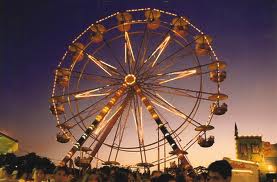 s of Vermont Yankee nuclear power plant; a pictorial look back at the Clinch River Breeder Reactor as small modular reactors are planned to take over the old site; something rotten in Denmark wind power; nuclear power technology advances in Russia and China...
s of Vermont Yankee nuclear power plant; a pictorial look back at the Clinch River Breeder Reactor as small modular reactors are planned to take over the old site; something rotten in Denmark wind power; nuclear power technology advances in Russia and China...
The weekend of December 1-2, 2012, sees three events of note relative to the history of nuclear energy.
A joint Department of Energy and NASA team has demonstrated a simple, robust fission reactor prototype [note: see Comments for more accurate and complete description] intended for development for future space exploration missions. The DUFF (Demonstration Using Flattop Fissions) experiment represents the first demonstration in the United State-since 1965-of a space nuclear reactor system to produce electricity.
Integrating Storage, Transportation, and Disposal
 On November 7, an important hearing about the Vermont Yankee nuclear power plant was held before the Vermont Public Service Board. Howard Shaffer has an excellent post on this hearing at ANS Nuclear Cafe.
On November 7, an important hearing about the Vermont Yankee nuclear power plant was held before the Vermont Public Service Board. Howard Shaffer has an excellent post on this hearing at ANS Nuclear Cafe.
In September 2012, American Nuclear Society members in the Tennessee Valley area turned out in record numbers to support an ANS presence at a public hearing in order to inform the public and media about the nonproliferation benefits of the mixed-oxide (MOX) fuel program. These remarkable volunteer efforts were recognized in several venues at the 2012 ANS Winter Conference & Technology Expo, including the ANS Public Information (PI) Committee meeting, the ANS Board of Directors, and the ANS PI Workshop hosted by Mimi Limbach of Potomac Communications and Craig Piercy, ANS rep in Washington, D.C. The decision was made at the PI Workshop to designate the official name of the Chattanooga hearing as the "Chattanooga Caper."
The 132nd weekly Carnival of Nuclear Energy Bloggers is posted at The Hiroshima Syndrome. This week's topics include: Russia's full-scale push to become totally nuclear by 2100; families of Vermont  Yankee employees share what it feels like to be faced with uncertainty about the extension of a nuclear power plant operating license; how emotions should favor nuclear energy; how it seems nuclear energy isn't that big a political issue in Japan; and natural gas... being more dangerous than nuclear energy. For the full reports, see The Hiroshima Syndrome (the internet's top source for Fukushima updates and commentary).
Yankee employees share what it feels like to be faced with uncertainty about the extension of a nuclear power plant operating license; how emotions should favor nuclear energy; how it seems nuclear energy isn't that big a political issue in Japan; and natural gas... being more dangerous than nuclear energy. For the full reports, see The Hiroshima Syndrome (the internet's top source for Fukushima updates and commentary).
 In my September post at the ANS Nuclear Cafe, I discussed the Democratic and Republican party platforms, along with their potential impacts on nuclear energy. With the 2012 U.S. elections now behind us, this post provides a post-election follow up, and discusses the impacts of the election results on nuclear's prospects over the near- to mid-term.
In my September post at the ANS Nuclear Cafe, I discussed the Democratic and Republican party platforms, along with their potential impacts on nuclear energy. With the 2012 U.S. elections now behind us, this post provides a post-election follow up, and discusses the impacts of the election results on nuclear's prospects over the near- to mid-term.
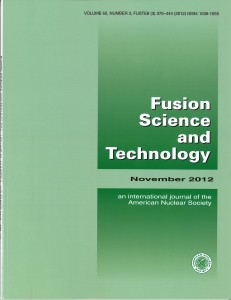 The November 2012 edition of the technical journal Fusion Science and Technology (FST) is available electronically and in hard copy for American Nuclear Society member subscribers and others. Non-subscribers click here to subscribe to FST and other ANS titles.
The November 2012 edition of the technical journal Fusion Science and Technology (FST) is available electronically and in hard copy for American Nuclear Society member subscribers and others. Non-subscribers click here to subscribe to FST and other ANS titles.